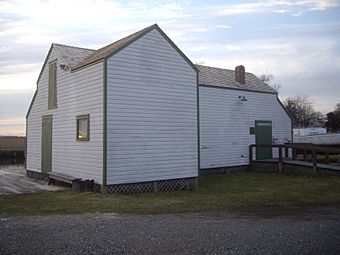Rudolph Oyster House facts for kids
|
Rudolph Oyster House
|
|
 |
|
| Location | 84 West Ave., West Sayville, NY |
|---|---|
| Area | less than one acre |
| Built | 1908 |
| Architectural style | marine industrial |
| NRHP reference No. | 01001052 |
Quick facts for kids Significant dates |
|
| Added to NRHP | August 7, 2001 |
| Designated NHL | August 7, 2001 |
The Rudolph Oyster House is a special old building. It's found at the Long Island Maritime Museum in West Sayville, New York. This building was put up in 1908. It's a rare and well-kept example of a place where oysters were prepared. Many buildings like it used to be along the local waterfront. The Rudolph Oyster House was named a National Historic Landmark in 2001. This means it's a very important historical site.
Contents
What is the Rudolph Oyster House?
The Rudolph Oyster House is located right on the water. It is part of the Long Island Maritime Museum. This building is made of wood and has only one floor. It sits on strong wooden poles. The building is about 44.5 feet long and 16.5 feet wide.
How the Building Looks Inside and Out
The outside of the building has wooden boards called clapboards. It has a roof that slopes down on two sides, called a gabled roof. On the west side of the roof, there's a special lower part. This lower part has glass skylights. These skylights let in lots of natural light. This was important for the workers inside. The inside of the building still has its original tools. These tools were used to sort, shuck (open), and pack oysters.
History of the Rudolph Oyster House
The Rudolph Oyster House is a typical "cullhouse." A cullhouse is where oysters are sorted and prepared. William Rudolph built it in 1908. His parents were immigrants from the Netherlands. The building was first located on the waterfront near Shore Road.
Moving the Oyster House
The building was later moved to its current spot. This new spot is about 600 feet away. The museum bought the building in 1974. That's when it was moved to the museum grounds.
The Rudolph Family Business
William Rudolph started his oyster company in 1895. He grew up working with oysters in the Great South Bay. William and then his sons ran the oyster business. They kept it going until 1947. The museum later saved this important building.



